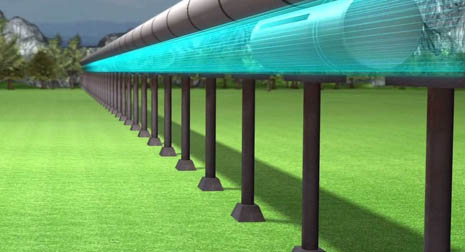Hyperloop-The Transport of the Future to Break Ground Next Year

Sound like sci-fi? Not anymore. The Hyperloop, brainchild of SpaceX and Tesla founder Elon Musk, now has several companies pushing the development forward.
Hyperloop Transportation Technologies (HTT) is one of several companies developing Hyperloop technology. One of the largest startup companies in the world, HTT announced on Thursday that it plans to team up with Swiss technology company Oerlikon and the world’s largest construction engineering firm, AECOM. They will also be joined by design studio Hodgetts+Fung.
Oerlikon has been working with vacuum technologies for more than a century, and took part in building the Large Hadron Collider. It sees the lofty vision of the Hyperloop as realistic.
****
HTT also announced it will begin construction on a 5-mile testing rail for the Hyperloop in Quay Valley, just north of Los Angeles, by May of next year. To test the pods at longer distances, HTT eventually plans to build facilities in Asia or Africa, where it is easier to secure land for construction, according to Hyperloop CEO Dirk Ahlborn said.
The futuristic transport, ambitiously described by Musk as being an entirely new mode of transportation, now has a team of more than 400 members, each working within his or her own sphere of expertise.
And no one, including the CEO, is getting paid for the job.
Instead, Hyperloop developers work on the project for at least 10 hours per week during their spare time. But people don’t work for nothing – if all goes according to plan, they’ll receive Hyperloop stock in exchange for completing the job.
Magnetically levitated trains are currently in operation in Shanghai and Tokyo, and can travel at a speed of 310 mph (500 km/h). While these trains use magnets to produce lift and propulsion, the Hyperloop would rely on compressed air for lift and magnets for propulsion.
In theory, Hyperloop capsules could reach blistering speeds, far outpacing current modes of commercial transport, since their enclosure within the tube would make them immune to air resistance.
On the other hand, the Hyperloop is vulnerable to one major flaw. If the walls of the tubes are not straight, or if the vacuum in the tube is compromised, then a crash is inevitable, experts estimate. Reliance on the compressor of individual pods is also a big deal. If the compressor fails, the capsule will crash into the walls.
It still remains unclear if the system will be as cheap as promised by its proponents. According to Hyperloop Transportation Technologies’ estimates, the five-mile test track will cost approximately $100 million. A proposed 400-mile track between Los Angeles and San Francisco would cost an estimated $8 billion.
However, since the track must be built to precise measurements, that cost will inevitably climb higher, analysts predict.















































